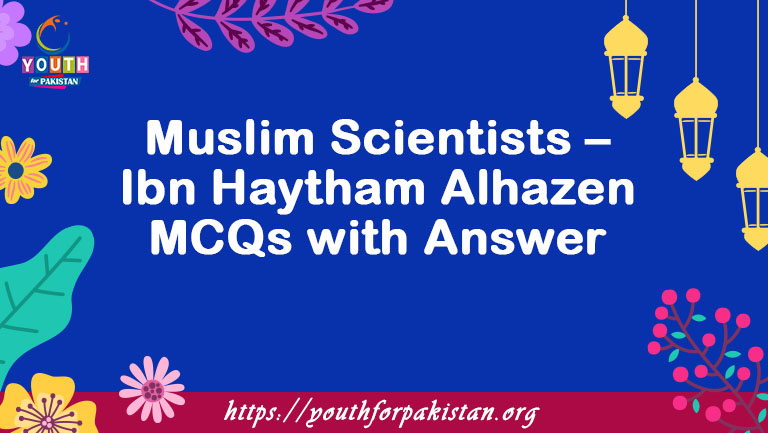The following are Muslim Scientists – Ibn al-Haytham Alhazen MCQs with answers related to Islamic Studies. We have arranged the most important and repeated MCQs in all the competitive examinations. The students can clear their concepts for Muslim Scientists – Ibn al-Haytham Alhazen MCQs online quiz by attempting these.
Muslim Scientists – Ibn al-Haytham Alhazen Online MCQs with Answers
What was the full name of the Muslim scientist commonly known as Ibn al-Haytham?
A) Ibn Sina
B) Ibn Khaldun
C) Ibn al-Haytham
D) Ibn Rushd
Ibn al-Haytham is often referred to as the “father of what”?
A) Optics
B) Chemistry
C) Algebra
D) Astronomy
In which Islamic Golden Age city was Ibn al-Haytham born?
A) Baghdad
B) Cairo
C) Basra
D) Damascus
Ibn al-Haytham made significant contributions to which branch of science that deals with the behavior of light?
A) Optics
B) Chemistry
C) Astronomy
D) Medicine
What is the name of Ibn al-Haytham’s most famous work on optics, often translated as “The Book of Optics”?
A) Al-Risalah al-Shamilah
B) Al-Kitab al-Mawardi
C) Al-Qanun al-Mas’udi
D) Kitab al-Manazir
Ibn al-Haytham’s work on optics laid the foundation for the modern understanding of what optical phenomenon?
A) Refraction
B) Reflection
C) Dispersion
D) Diffraction
Ibn al-Haytham’s studies on vision and the eye led to his correct understanding of how vision occurs. Which part of the eye did he identify as responsible for forming images?
A) Retina
B) Cornea
C) Lens
D) Iris
What principle, often credited to Ibn al-Haytham, describes the path that light takes when it passes from one medium to another and changes direction?
A) Snell’s Law
B) Kepler’s Law
C) Hubble’s Law
D) Ohm’s Law
Ibn al-Haytham’s contributions to optics were crucial for the development of what later scientific device?
A) Telescope
B) Microscope
C) Spectrometer
D) X-ray machine
Which famous Greek philosopher’s work on optics greatly influenced Ibn al-Haytham’s own studies in the field?
A) Socrates
B) Plato
C) Aristotle
D) Euclid
Ibn al-Haytham’s groundbreaking work on optics included the first correct explanation of what natural occurrence?
A) Rainbow
B) Earthquake
C) Solar eclipse
D) Volcano eruption
Which of the following is NOT an area of study that Ibn al-Haytham made significant contributions to?
A) Mathematics
B) Medicine
C) Astronomy
D) Chemistry
In his work on optics, Ibn al-Haytham emphasized the importance of what in the scientific method?
A) Experimentation
B) Intuition
C) Revelation
D) Deduction
Which ancient Greek philosopher’s work did Ibn al-Haytham criticize and improve upon in his studies on light and vision?
A) Plato
B) Socrates
C) Aristotle
D) Euclid
Ibn al-Haytham’s contributions to optics extended beyond theory; he also designed what optical instrument for practical use?
A) Microscope
B) Camera obscura
C) Telescope
D) Microscope
Which Latin scholar played a key role in transmitting Ibn al-Haytham’s works on optics to the Western world during the Middle Ages?
A) Galileo Galilei
B) Johannes Kepler
C) Roger Bacon
D) Nicolaus Copernicus
Ibn al-Haytham made contributions to which branch of science by studying the anatomy and function of the eye?
A) Medicine
B) Biology
C) Geology
D) Astronomy
Ibn al-Haytham’s studies on the nature of light challenged the ideas of which ancient Greek philosopher regarding vision?
A) Socrates
B) Plato
C) Aristotle
D) Euclid
Which Islamic Golden Age scholar is often credited with introducing the scientific method, which Ibn al-Haytham embraced in his work?
A) Al-Razi
B) Al-Kindi
C) Al-Biruni
D) Ibn Sina
What is the term for the phenomenon that Ibn al-Haytham described as the ability of a pinhole to project an inverted image of an external scene onto a surface?
A) Diffraction
B) Refraction
C) Pinhole effect
D) Camera obscura
In addition to optics, Ibn al-Haytham made significant contributions to which other field of science?
A) Astronomy
B) Chemistry
C) Geology
D) Mathematics
What is the term for the natural phenomenon of light bending when it passes through different media, which Ibn al-Haytham studied extensively?
A) Diffraction
B) Reflection
C) Refraction
D) Dispersion
Ibn al-Haytham’s work on optics laid the foundation for the development of what later scientific device?
A) Telescope
B) Microscope
C) Spectrometer
D) X-ray machine
What principle, often credited to Ibn al-Haytham, describes the path that light takes when it passes from one medium to another and changes direction?
A) Snell’s Law
B) Kepler’s Law
C) Hubble’s Law
D) Ohm’s Law
Ibn al-Haytham’s contributions to optics were crucial for the development of what later scientific device?
A) Telescope
B) Microscope
C) Spectrometer
D) X-ray machine
Which famous Greek philosopher’s work on optics greatly influenced Ibn al-Haytham’s own studies in the field?
A) Socrates
B) Plato
C) Aristotle
D) Euclid
Ibn al-Haytham’s groundbreaking work on optics included the first correct explanation of what natural occurrence?
A) Rainbow
B) Earthquake
C) Solar eclipse
D) Volcano eruption
Which of the following is NOT an area of study that Ibn al-Haytham made significant contributions to?
A) Mathematics
B) Medicine
C) Astronomy
D) Chemistry
In his work on optics, Ibn al-Haytham emphasized the importance of what in the scientific method?
A) Experimentation
B) Intuition
C) Revelation
D) Deduction
Which ancient Greek philosopher’s work did Ibn al-Haytham criticize and improve upon in his studies on light and vision?
A) Plato
B) Socrates
C) Aristotle
D) Euclid
Ibn al-Haytham’s contributions to optics extended beyond theory; he also designed what optical instrument for practical use?
A) Microscope
B) Camera obscura
C) Telescope
D) Microscope
Which Latin scholar played a key role in transmitting Ibn al-Haytham’s works on optics to the Western world during the Middle Ages?
A) Galileo Galilei
B) Johannes Kepler
C) Roger Bacon
D) Nicolaus Copernicus
Ibn al-Haytham made contributions to which branch of science by studying the anatomy and function of the eye?
A) Medicine
B) Biology
C) Geology
D) Astronomy
Ibn al-Haytham’s studies on the nature of light challenged the ideas of which ancient Greek philosopher regarding vision?
A) Socrates
B) Plato
C) Aristotle
D) Euclid
Which Islamic Golden Age scholar is often credited with introducing the scientific method, which Ibn al-Haytham embraced in his work?
A) Al-Razi
B) Al-Kindi
C) Al-Biruni
D) Ibn Sina
What is the term for the phenomenon that Ibn al-Haytham described as the ability of a pinhole to project an inverted image of an external scene onto a surface?
A) Diffraction
B) Refraction
C) Pinhole effect
D) Camera obscura
In addition to optics, Ibn al-Haytham made significant contributions to which other field of science?
A) Astronomy
B) Chemistry
C) Geology
D) Mathematics
What is the term for the natural phenomenon of light bending when it passes through different media, which Ibn al-Haytham studied extensively?
A) Diffraction
B) Reflection
C) Refraction
D) Dispersion
Ibn al-Haytham’s work on optics laid the foundation for the development of what later scientific device?
A) Telescope
B) Microscope
C) Spectrometer
D) X-ray machine
What principle, often credited to Ibn al-Haytham, describes the path that light takes when it passes from one medium to another and changes direction?
A) Snell’s Law
B) Kepler’s Law
C) Hubble’s Law
D) Ohm’s Law
Ibn al-Haytham’s contributions to optics were crucial for the development of what later scientific device?
A) Telescope
B) Microscope
C) Spectrometer
D) X-ray machine
Which famous Greek philosopher’s work on optics greatly influenced Ibn al-Haytham’s own studies in the field?
A) Socrates
B) Plato
C) Aristotle
D) Euclid
Ibn al-Haytham’s groundbreaking work on optics included the first correct explanation of what natural occurrence?
A) Rainbow
B) Earthquake
C) Solar eclipse
D) Volcano eruption
Which of the following is NOT an area of study that Ibn al-Haytham made significant contributions to?
A) Mathematics
B) Medicine
C) Astronomy
D) Chemistry
In his work on optics, Ibn al-Haytham emphasized the importance of what in the scientific method?
A) Experimentation
B) Intuition
C) Revelation
D) Deduction
Which ancient Greek philosopher’s work did Ibn al-Haytham criticize and improve upon in his studies on light and vision?
A) Plato
B) Socrates
C) Aristotle
D) Euclid
Ibn al-Haytham’s contributions to optics extended beyond theory; he also designed what optical instrument for practical use?
A) Microscope
B) Camera obscura
C) Telescope
D) Microscope
Which Latin scholar played a key role in transmitting Ibn al-Haytham’s works on optics to the Western world during the Middle Ages?
A) Galileo Galilei
B) Johannes Kepler
C) Roger Bacon
D) Nicolaus Copernicus
Ibn al-Haytham made contributions to which branch of science by studying the anatomy and function of the eye?
A) Medicine
B) Biology
C) Geology
D) Astronomy
Ibn al-Haytham’s studies on the nature of light challenged the ideas of which ancient Greek philosopher regarding vision?
A) Socrates
B) Plato
C) Aristotle
D) Euclid










